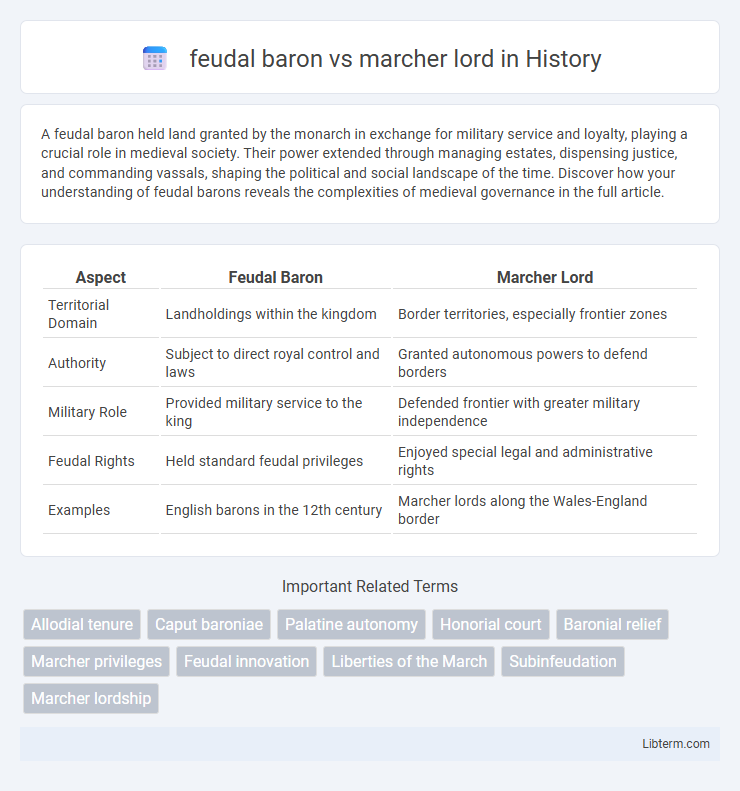A feudal baron held land granted by the monarch in exchange for military service and loyalty, playing a crucial role in medieval society. Their power extended through managing estates, dispensing justice, and commanding vassals, shaping the political and social landscape of the time. Discover how your understanding of feudal barons reveals the complexities of medieval governance in the full article.
Table of Comparison
| Aspect | Feudal Baron | Marcher Lord |
|---|---|---|
| Territorial Domain | Landholdings within the kingdom | Border territories, especially frontier zones |
| Authority | Subject to direct royal control and laws | Granted autonomous powers to defend borders |
| Military Role | Provided military service to the king | Defended frontier with greater military independence |
| Feudal Rights | Held standard feudal privileges | Enjoyed special legal and administrative rights |
| Examples | English barons in the 12th century | Marcher lords along the Wales-England border |
Introduction to Feudal Barons and Marcher Lords
Feudal barons were landholders granted estates directly by the monarch, responsible for providing military service and administering justice within their territories. Marcher lords held lands along the volatile borders of the English kingdom, particularly in Wales and Scotland, with autonomous powers to defend and govern these frontier regions. Their distinct roles reflected the balance of authority and military duty essential to maintaining medieval English stability.
Historical Context and Origins
Feudal barons emerged in medieval England as hereditary landholders granted estates directly by the king, establishing local authority within the feudal hierarchy. Marcher lords, originating along the volatile borderlands between England and Wales, held semi-autonomous powers to defend and expand frontier territories, blending military and administrative roles. The distinct historical context of the Welsh Marches shaped marcher lordships with extended privileges beyond those of typical feudal baronies, reflecting their strategic significance.
Geographic Distribution and Significance
Feudal barons primarily held lands within the core regions of medieval England and France, exerting localized authority over manors and villages. Marcher lords governed the volatile borderlands known as the Marches, particularly along the England-Wales and England-Scotland frontiers, where their powers included military and judicial privileges to secure these frontier zones. The geographic distribution of marcher lordships highlights their strategic importance in defense and expansion, contrasting with the feudal barons' role in stabilizing established territories.
Legal Status and Powers
A feudal baron held land directly from the king with hereditary rights and owed military service, enjoying autonomous jurisdiction within their barony, including the right to hold courts and administer justice. A marcher lord governed border territories called Marches with special privileges granted to defend and expand frontier lands, wielding extraordinary military and judicial powers often exempt from royal interference. These lords exercised near-sovereign authority, including raising armies and imposing laws, reflecting their essential role in securing contested border regions.
Military Responsibilities and Autonomy
Feudal barons held military responsibilities primarily tied to providing armed men to their liege lord during wartime, with limited autonomy constrained by the lord's direct control and royal laws. Marcher lords, positioned on the volatile borders of medieval kingdoms, commanded greater military autonomy, possessing rights to raise armies, build castles, and conduct warfare independently to defend and expand frontier territories. This distinction granted marcher lords exceptional authority and flexibility in military matters compared to the more hierarchically bound feudal barons.
Relationships with the Crown
Feudal barons held land directly from the Crown and owed military service and counsel as part of their vassal obligations. Marcher lords operated with greater autonomy along the borderlands, often granted special privileges by the Crown to maintain defense and regional control. Their relationship with the Crown combined direct allegiance with privileges that allowed them to exercise quasi-sovereign powers absent in typical feudal baronies.
Land Ownership and Administration
Feudal barons held large estates granted directly by the monarch, with authority to manage land, collect rents, and preside over local courts within their barony. Marcher lords controlled border territories known as Marches, where they exercised quasi-sovereign powers, including military defense, judicial independence, and the right to fortify castles. The administration of marcher lordships involved greater autonomy and flexibility to respond to frontier challenges compared to the more hierarchical and centralized management typical of feudal baronies.
Role in Border Security and Expansion
Feudal barons primarily managed land and upheld law within established territories, while marcher lords held specialized military and administrative authority along volatile border regions. Marcher lords were tasked with defending frontiers and initiating territorial expansion through fortified castles and local militias. Their role was crucial for securing borderlands and facilitating the kingdom's gradual territorial growth.
Decline and Legacy in Modern History
The decline of feudal barons occurred as centralized monarchies consolidated power, diminishing localized noble authority and integrating baronial lands into national governance structures. Marcher lords, originally granted autonomous control to defend border regions, saw their military and administrative privileges erode with the establishment of stronger state institutions and formal legal systems. The legacy of feudal barons and marcher lords persists in modern property law, territorial administration, and regional identities, influencing contemporary concepts of local governance and aristocratic heritage.
Key Differences: Feudal Baron vs. Marcher Lord
Feudal barons held land granted directly by the king, managing their estates primarily through agricultural production and local judicial authority within established English counties. Marcher lords, on the other hand, operated on the volatile borderlands between England and Wales, possessing extraordinary military powers and quasi-independent jurisdiction to defend and expand the frontier. The marcher lord's autonomy contrasted sharply with the feudal baron's more regulated governance under the strict hierarchy of the English crown.
feudal baron Infographic

 libterm.com
libterm.com